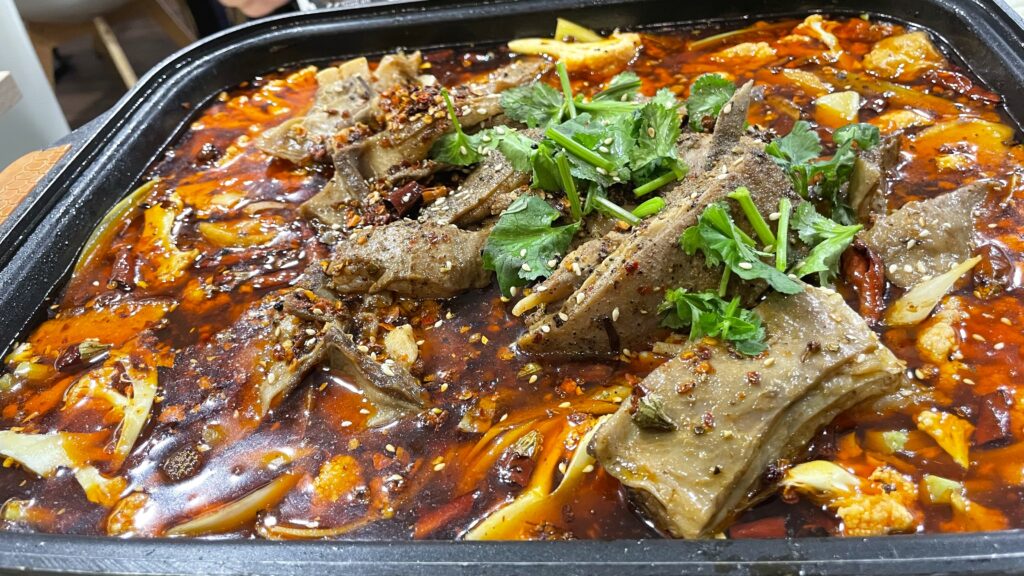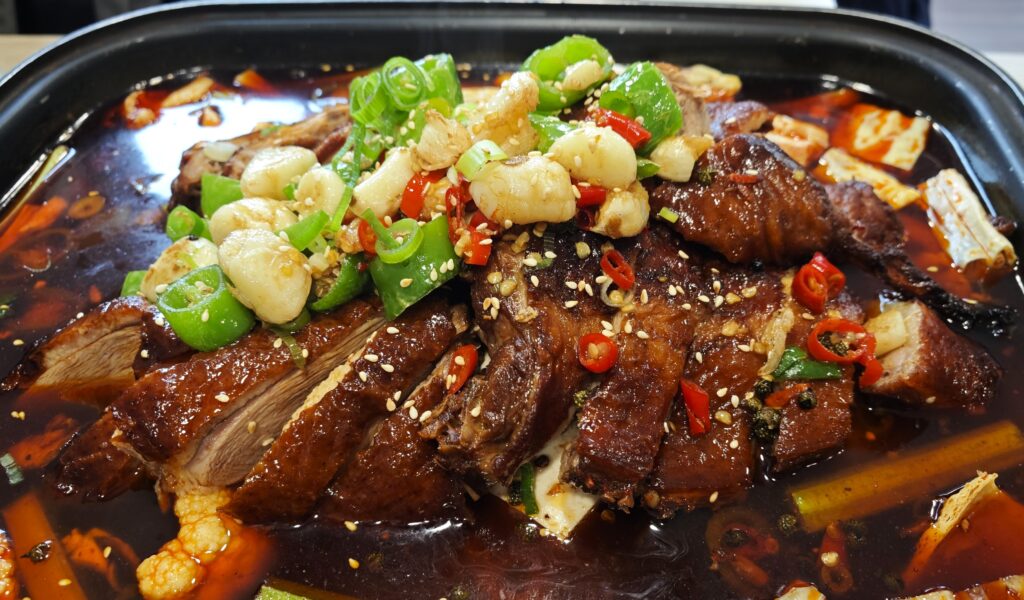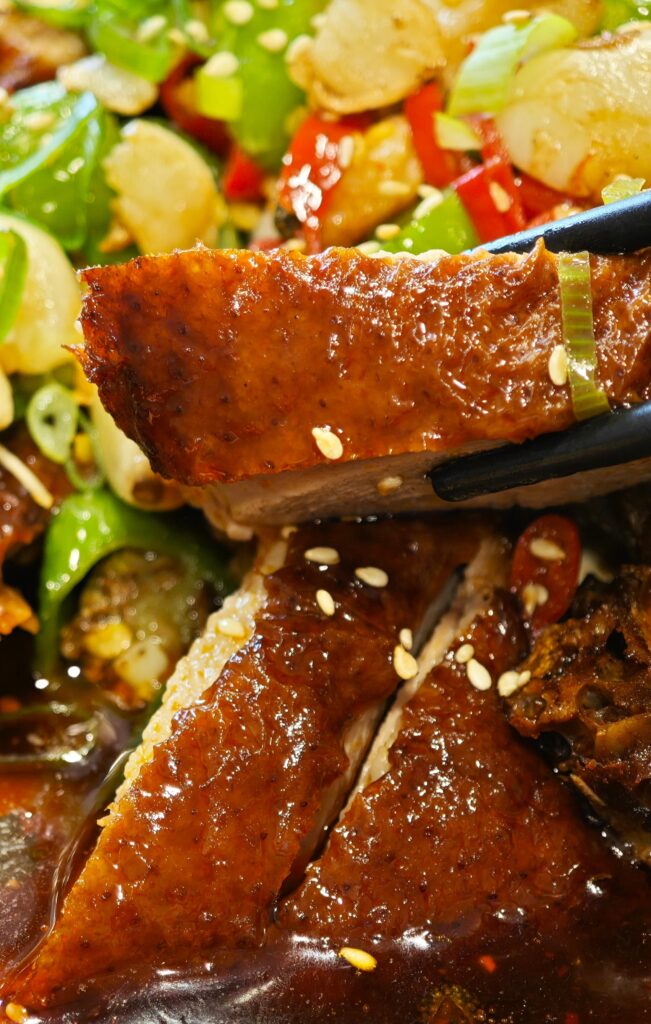Welcome back to the flavorful world of Hao Chi Bites, where today we’ll talk about a heaty dish tailor-made for the chilly weather: the irresistible Lamb Pot (also known as 羊肉锅 Yang Rou Guo). Imagine tender lamb simmering in a fragrant broth, filling the air with comforting aromas and wrapping you in a blanket of warmth from the inside out. It’s not just delicious – it’s a winter essential!
The lamb pot at China Haus is similar to the Northern Chinese Lamb Pot, a beloved winter comfort food, highly favored for its nourishing properties. Many of my Northern friends insist that the best lamb must be savored in the North, where the highest quality is found. They enjoy lamb soup, sometimes even for breakfast. As winter descends, lamb becomes a non-negotiable, especially when it’s locally raised. In rural areas, home-raised lambs roam freely, feeding on natural pastures. The pot, stewed with purebred quality lamb, promises a taste of heaven itself!
In Northern China, lamb pot often features a clear broth. The chef at China Haus, I’m told, is from Sichuan, so they gave it a Sichuan twist. Curious, we couldn’t resist trying it.
Restaurant Profile
- Name of the Restaurant: China Haus 小食代
- Adress: Schloßstraße 52, 60486 Frankfurt am Main
- Style: Chinese Cuisine
- Price: around 15 – 25 EUR per Person (incl. Drinks and Tips)
Now get ready for a feast fit for 2-4 hungry souls at a great price! The pot is enormous, brimming with tender lamb, accompanied by a colorful array of vegetables such as cauliflower, potatoes, onions, and celery. And there’s more! An additional plate of veggies awaits, with wood ear mushrooms, tofu, cabbage, seaweed, and delicate vermicelli (also known as 粉条 Fen Tiao).

It’s reminiscent of hotpot, but with its own unique twist. The lamb has been slow-cooked to perfection, resulting in meat so tender that it falls off the bone with ease. As the pot bubbles away, the savory broth intensifies, infused with the aromatic blend of Sichuan spices – numbing Sichuan peppercorns, fiery chilies, fragrant sesame, star anise, coriander, ginger, and onions.
While the lamb is ready to eat right after serving, the veggies benefit from a quick 3-5 minute simmer in the bubbling broth to soak up all the deliciousness. Quick-cooking items like wood ear mushrooms, seaweed, tofu, and cabbage need just a few minutes (about 5-10 minutes), while the noodles cook even faster (2-3 minutes). But beware – the delicate vermicelli may vanish if left in the pot too long, so keep an eye on them!

The lamb portion is more than generous, offering an endless ocean of savory goodness.

The lamb used is slightly fatty ribs, paired with ingredients like scallions, ginger, garlic to eliminate any gaminess and retain its unique texture. Simmering allows the vegetables to gradually absorb the lamb’s richness, soaking up the flavorful fat and gaining an incredibly rich taste.
Each bite reveals tender, rich meat enhanced by the luxurious richness of the rendered fat. The assorted veggies serve as the perfect complement, balancing out the robust aroma of the lamb.

It’s an absolute explosion of addictive flavors! Those who normally shy away from lamb will most likely have a change of heart after tasting this Lamb Pot.

Beyond winter, in Northern regions, it’s traditional custom to eat lamb during the Double Ninth Festival (also known as 九九重阳节 Jiu Jiu Chong Yang Jie). It falls on the ninth day of the ninth month of the lunar calendar when the Sun and Moon align in Yang energy (as mentioned in the “Book of Changes” 易经 Yi Jing, an ancient Chinese philosophical classic dating back to the 9th century BC).
In ancient China, this day was associated with the harvest festival and worshiping ancestors, in gratitude for their blessings. The significance of “nine” (九 Jiu), which is synonymous with “longevity”(久 Jiu), has led to the festival being regarded as a day to honor the elderly, known as “Senior Citizens’ Day” or “Respect for the Elderly Day”.
Now, you may wonder why lamb is eaten during the Double Ninth Festival. As autumn deepens in September, the weather turns colder, and lamb’s warmth is believed to help ward off the chill. Elderly people, who are usually less resistant to the cold, especially benefit from this tradition. The homophony between “羊” (Yang, meaning lamb in Chinese) and “阳” (Yang as in Yin and Yang Energy and 九九重阳节 Jiu Jiu Chong Yang Jie) symbolizing warmth and positivity, also fits the festival’s spirit perfectly.
As families gather to enjoy delicious, tender lamb dishes, they trust lamb’s warmth to protect the elderly from the winter’s bite, help them stay healthy during the colder months, while fostering cherished moments of familial bonding during the frosty Northern seasons.

A fresh update: China Haus offers this type of hot pot dining in creative combinations – beyond lamb pot, you can try Fish Pot, which combines grilled fish with hot pot, or Half-Fish-Half-Lamb Pot. Their recent addition, Duck Pot (冒烤鸭), is not to be missed. This dish features a whole duck, grilled until the skin turns golden and crispy, while meat remains juicy and tender. The duck is savored in a simmering hot pot broth, blending the deep, roasted duck flavor with the spicy, aromatic Chinese hot pot.

This dish features a whole duck, grilled until the skin turns golden and crispy, while meat remains juicy and tender.


The duck is savored in a simmering hot pot broth, blending the deep, roasted duck flavor with the spicy, aromatic Chinese hot pot.

The Duck Pot is generously packed with veggies, including celery, cauliflower, and tofu, along with classic sides like fish balls, crab sticks (蟹柳), beef tripe (毛肚), and thick udon noodles (乌冬面). Topped with heaps of garlic and long green peppers, it’s aromatic, spicy, and absolutely delicious! At €38, this dish comfortably serves 3–4 people, making it perfect for sharing with friends or family.

If you’re intrigued by the idea of communal dining like lamb pot or hotpot, don’t miss out on our previous posts on Sichuan Grill Fish Kaoyu and Sizzle & Dip Dual Yum, a fusion of hotpot and BBQ. Trust us, they’re just as irresistible!




